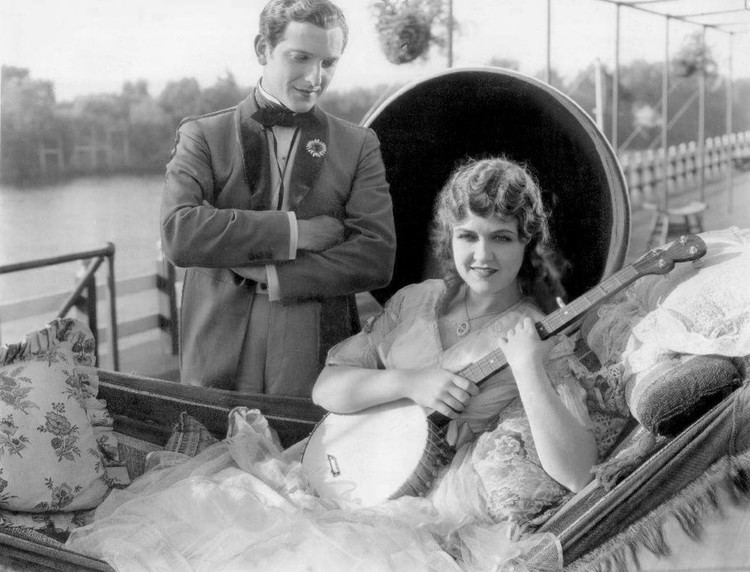On with the Show (1929 film)
6.2 /10 1 Votes
Director Alan Crosland Music director Harry Akst Country United States | 6.2/10 IMDb Genre Musical, Romance Duration Language English | |||||||||||||||||||||||||||||||||
 | ||||||||||||||||||||||||||||||||||
Release date May 28, 1929 Based on Shoestring
by Humphrey Pearson Writer Humphrey Pearson (based on the play "Shoestring" by), Robert Lord (scenario) Screenplay Robert Lord, Humphrey Pearson Cast Arthur Lake (Harold), Betty Compson (Nita), Sally O'Neil (Kitty), William Bakewell (Jimmy), Joe E. Brown (Joe Beaton), Ethel Waters (Ethel)Similar movies Betty Compson appears in On with the Show and Street Girl, The Broadway Melody (1929), Sally (1929), Step Lively (1944), Rio Rita (1929) | ||||||||||||||||||||||||||||||||||
Jerry (Sam Hardy) is at the end of his rope. His Broadway-bound musical is suffering from numerous setbacks during trial performances in New Jersey. Jerry must deal with temperamental leading lady Nita (Betty Compson), smug comic Joe Beaton (Joe E. Brown), starstruck chorus girl Kitty (Sally ONeil) and a dwindling supply of funds. During a performance, Nita storms off the stage to protest her poor compensation, and Kitty must take her place. Can Jerrys production be saved?
Contents

On with the Show! is a 1929 American musical film released by Warner Bros. The film is noted as the first ever all-talking, all-color feature length movie, and the second color movie released by Warner Bros.; the first was a partly color, black-and-white musical, The Desert Song (1929).
With unpaid actors and staff, the stage show Phantom Sweetheart seems doomed. To complicate matters, the box office takings have been robbed and the leading lady refuses to appear. Can the show be saved?
Plot
With unpaid actors and staff, the stage show Phantom Sweetheart seems doomed. To complicate matters, the box office takings have been robbed and the leading lady refuses to appear. The cast includes William Bakewell as the head usher eager to get his sweetheart, box-office girl Sally ONeil, noticed as a leading girl. Betty Compson plays the temperamental star and Arthur Lake the whiny young male lead. Louise Fazenda is the companys eccentric comedienne. Joe E. Brown plays the part of a mean comedian who constantly argues with Arthur Lake.
Cast
Songs
, and Danced by Marion Fairbanks and Madeline Fairbanks
Production and promotion
Warner Bros. promoted On with the Show! as being in "natural color." The pioneers of sound were the first to introduce full talking combined with full color. Adverts proclaimed Now color takes to the screen. For Warners this would be the first in a series of contracted films made in color.
The film generated much interest in Hollywood and virtually overnight, most other major studios began films shot in the process. The film would be eclipsed by the far greater success of the second Technicolor film, Gold Diggers of Broadway. (Song of the West was actually completed first but had its release delayed until March of 1930). The original negative of On With the Show is now lost and no Technicolor prints have survived, only prints in black-and-white. A fragment of an original color print lasting about 20 seconds surfaced in 2005; other original color fragments have also been discovered in 2014.
The film was a combination of a few genres. Part backstage musical using the now familiar show within a show format, part mystery and part comedy. It featured famed singer Ethel Waters in two songs written and staged for the film. "Am I Blue?" and "Birmingham Bertha" (with dancer John Bubbles).
Reception
The film was a box office hit, with a worldwide gross of over $2 million. Reviews from critics were mixed, however. Mordaunt Hall of The New York Times wrote that the film was "to be felicitated on the beauty of its pastel shades, which were obtained by the Technicolor process, but little praise can be accorded its story or to its raucous voices....It would have been better if this film had no story, and no sound, for it is like a clumsy person arrayed in Fifth Avenue finery." Variety reported that the film was "too long in running," but was nevertheless "impressive, both as an entertainment and as a talker." Film Daily called it "fine entertainment and a very adroit mixture of comedy, some rather bad pathos and musical comedy numbers." The New York Herald Tribune declared it "the best thing the films have done in the way of transferring Broadway music shows to the screen and, even if the story is bad and the entire picture considerably in need of cutting it is an admirable and frequently handsome bit of cinema exploring." John Mosher of The New Yorker wrote that the film was "completely undistinguished for wit, charm, or novelty, except that it is done in color. Possibly in the millennium all movies will be colored. In these early days of the art, however, not much can be said for it, except that it is not really distressing."
DVD release
In December 2009, On with the Show! (in Black-and-White) was made available on manufactured-on-demand DVD by the Warner Archive Collection.
References
On with the Show (1929 film) WikipediaOn with the Show (1929 film) IMDbOn with the Show (1929 film) themoviedb.org
